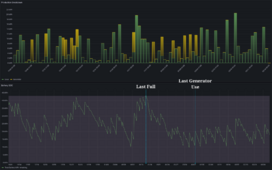Symbioquine
Solar Enthusiast
- Joined
- Jul 6, 2021
- Messages
- 428
We'll call the time where a system is neither all the way full nor too close to empty: "coasting"
IMHO, time spent coasting is one measure of how well an off-grid system is balanced in terms of production capacity, storage capacity, and usage.
Lots of ways to look at this, but;
So, post your numbers/graphs. I'm feeling pretty good about ~26 days "coasting" without generator and ~33 days including generator use. 43 kWh storage, 5.75 kW PV, Avg ~7 kWh/day usage.

Obviously, you can game this metric by limiting usage to match production so I bet some folks "coast" all winter... Kudos to you, tell us about it!
IMHO, time spent coasting is one measure of how well an off-grid system is balanced in terms of production capacity, storage capacity, and usage.
Lots of ways to look at this, but;
- If your production capacity is too large you'll spend a lot of time full and not getting the full value out of your solar panels (or wind/hydro/etc).
- If your storage capacity is too small (relative to production) you'll spend a lot of time either almost empty or full and either not have power to use or room to store power for the future use respectively.
- If your usage is too large or too small (relative to storage and production) you'll also spend a lot of time either almost empty or full and either not have power to use or room to store power for the future respectively.
So, post your numbers/graphs. I'm feeling pretty good about ~26 days "coasting" without generator and ~33 days including generator use. 43 kWh storage, 5.75 kW PV, Avg ~7 kWh/day usage.

Obviously, you can game this metric by limiting usage to match production so I bet some folks "coast" all winter... Kudos to you, tell us about it!


